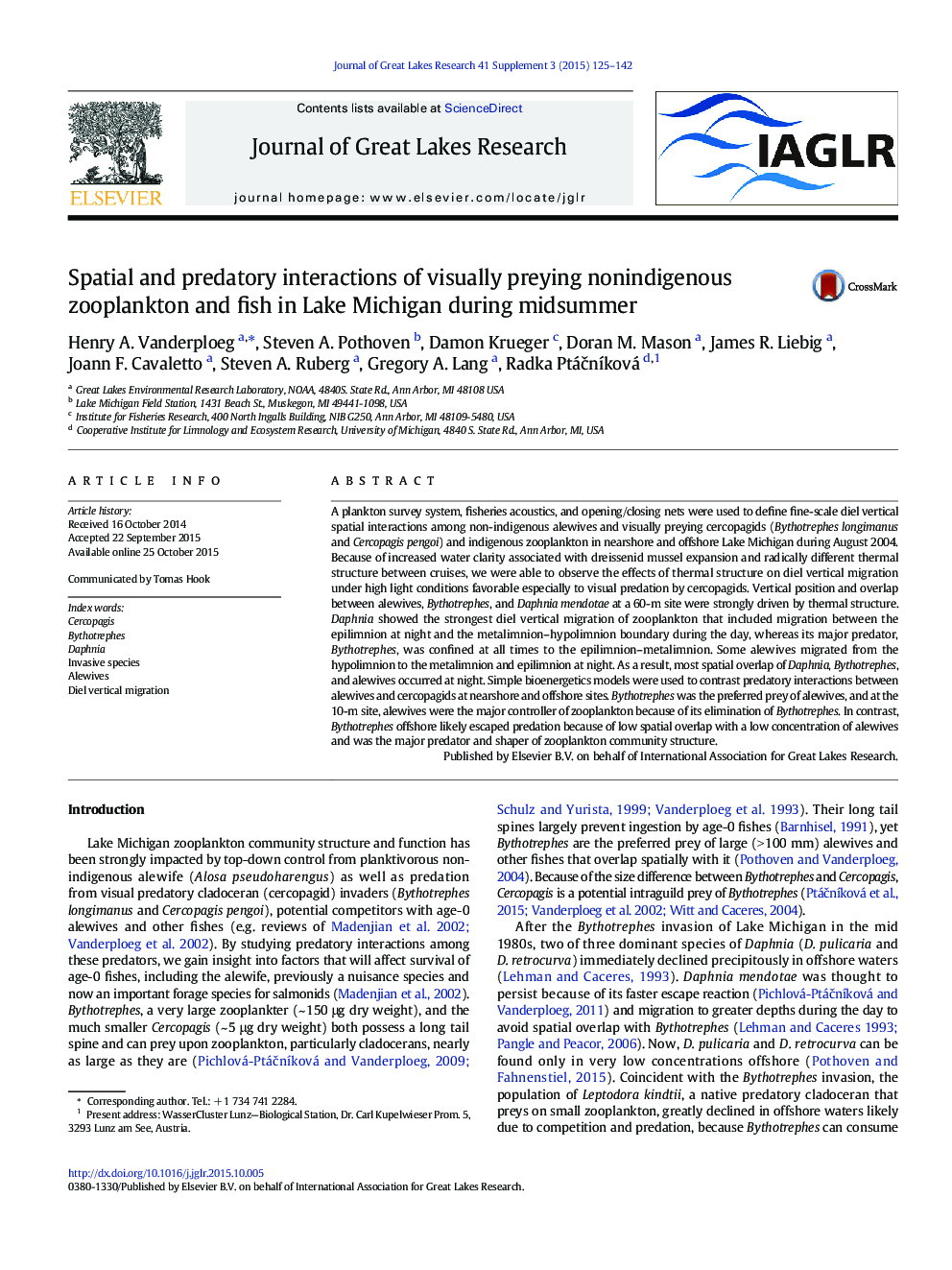| کد مقاله | کد نشریه | سال انتشار | مقاله انگلیسی | نسخه تمام متن |
|---|---|---|---|---|
| 6304914 | 1306677 | 2015 | 18 صفحه PDF | دانلود رایگان |
عنوان انگلیسی مقاله ISI
Spatial and predatory interactions of visually preying nonindigenous zooplankton and fish in Lake Michigan during midsummer
ترجمه فارسی عنوان
تعاملات فضایی و خرابکارانه بین زئوپلانکتون غیر زیستی و ماهی در دریاچه میشیگان در طول ماههای تابستان
دانلود مقاله + سفارش ترجمه
دانلود مقاله ISI انگلیسی
رایگان برای ایرانیان
کلمات کلیدی
موضوعات مرتبط
مهندسی و علوم پایه
علوم زمین و سیارات
علوم زمین و سیاره ای (عمومی)
چکیده انگلیسی
A plankton survey system, fisheries acoustics, and opening/closing nets were used to define fine-scale diel vertical spatial interactions among non-indigenous alewives and visually preying cercopagids (Bythotrephes longimanus and Cercopagis pengoi) and indigenous zooplankton in nearshore and offshore Lake Michigan during August 2004. Because of increased water clarity associated with dreissenid mussel expansion and radically different thermal structure between cruises, we were able to observe the effects of thermal structure on diel vertical migration under high light conditions favorable especially to visual predation by cercopagids. Vertical position and overlap between alewives, Bythotrephes, and Daphnia mendotae at a 60-m site were strongly driven by thermal structure. Daphnia showed the strongest diel vertical migration of zooplankton that included migration between the epilimnion at night and the metalimnion-hypolimnion boundary during the day, whereas its major predator, Bythotrephes, was confined at all times to the epilimnion-metalimnion. Some alewives migrated from the hypolimnion to the metalimnion and epilimnion at night. As a result, most spatial overlap of Daphnia, Bythotrephes, and alewives occurred at night. Simple bioenergetics models were used to contrast predatory interactions between alewives and cercopagids at nearshore and offshore sites. Bythotrephes was the preferred prey of alewives, and at the 10-m site, alewives were the major controller of zooplankton because of its elimination of Bythotrephes. In contrast, Bythotrephes offshore likely escaped predation because of low spatial overlap with a low concentration of alewives and was the major predator and shaper of zooplankton community structure.
ناشر
Database: Elsevier - ScienceDirect (ساینس دایرکت)
Journal: Journal of Great Lakes Research - Volume 41, Supplement 3, 2015, Pages 125-142
Journal: Journal of Great Lakes Research - Volume 41, Supplement 3, 2015, Pages 125-142
نویسندگان
Henry A. Vanderploeg, Steven A. Pothoven, Damon Krueger, Doran M. Mason, James R. Liebig, Joann F. Cavaletto, Steven A. Ruberg, Gregory A. Lang, Radka PtáÄnÃková,
